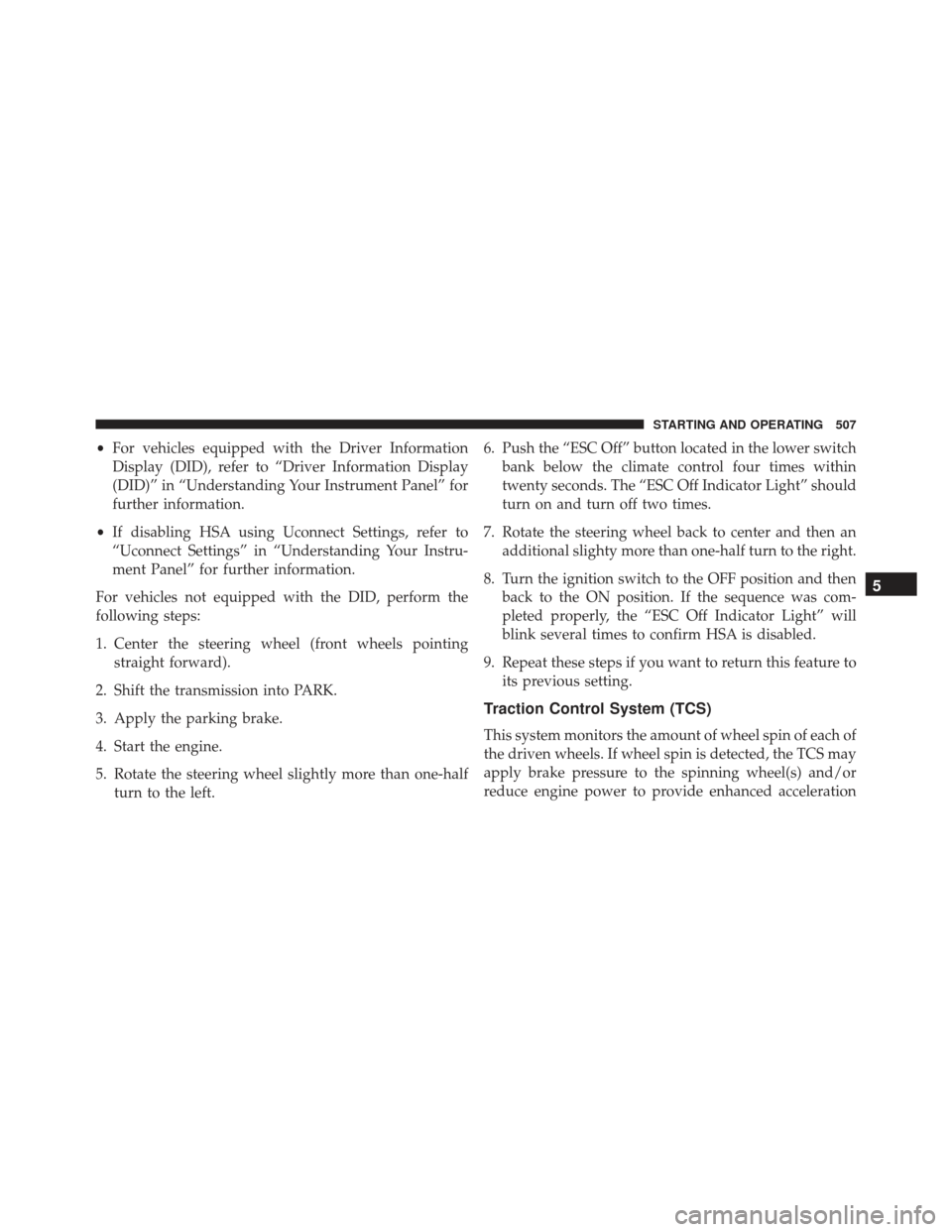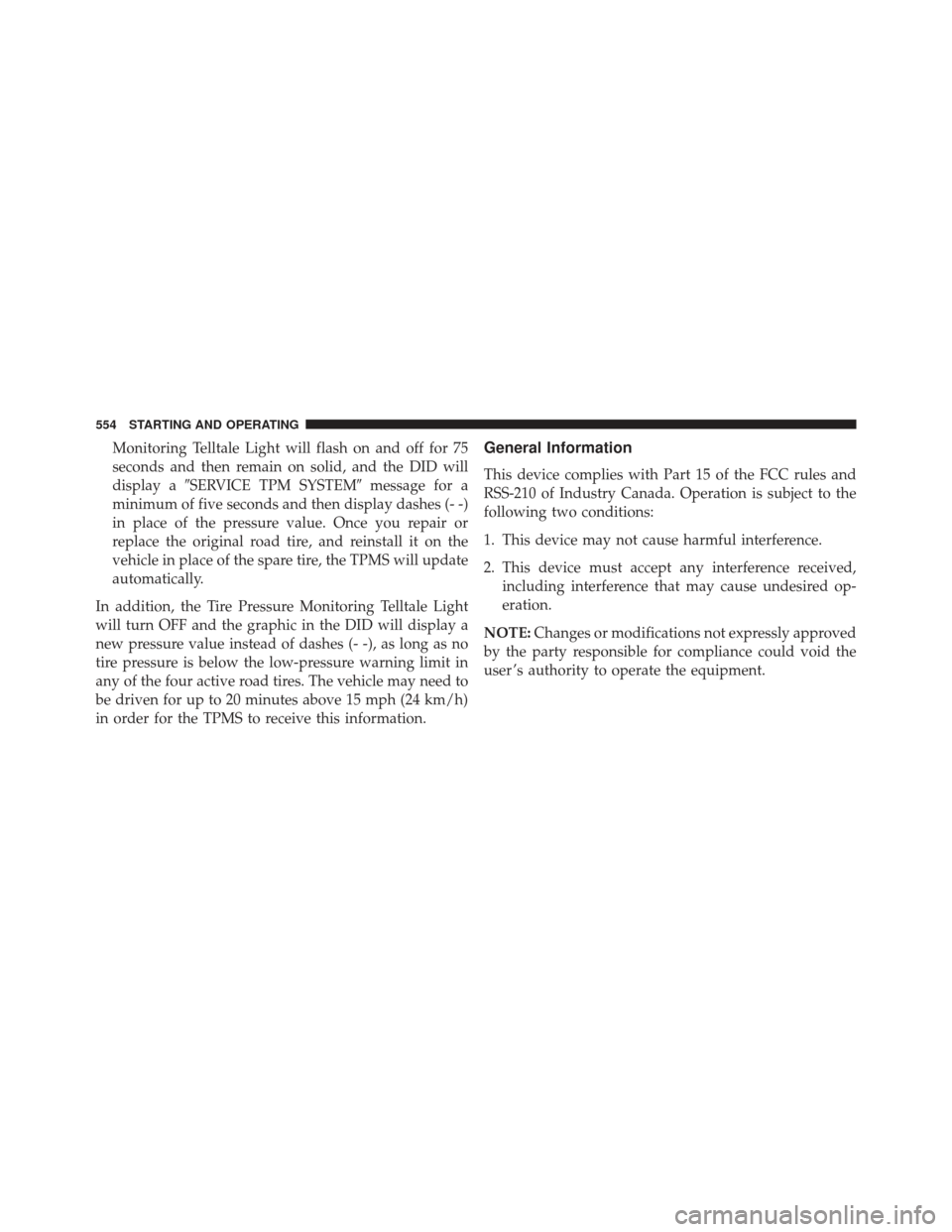Page 509 of 723

•For vehicles equipped with the Driver Information
Display (DID), refer to “Driver Information Display
(DID)” in “Understanding Your Instrument Panel” for
further information.
• If disabling HSA using Uconnect Settings, refer to
“Uconnect Settings” in “Understanding Your Instru-
ment Panel” for further information.
For vehicles not equipped with the DID, perform the
following steps:
1. Center the steering wheel (front wheels pointing straight forward).
2. Shift the transmission into PARK.
3. Apply the parking brake.
4. Start the engine.
5. Rotate the steering wheel slightly more than one-half turn to the left. 6. Push the “ESC Off” button located in the lower switch
bank below the climate control four times within
twenty seconds. The “ESC Off Indicator Light” should
turn on and turn off two times.
7. Rotate the steering wheel back to center and then an additional slighty more than one-half turn to the right.
8. Turn the ignition switch to the OFF position and then back to the ON position. If the sequence was com-
pleted properly, the “ESC Off Indicator Light” will
blink several times to confirm HSA is disabled.
9. Repeat these steps if you want to return this feature to its previous setting.
Traction Control System (TCS)
This system monitors the amount of wheel spin of each of
the driven wheels. If wheel spin is detected, the TCS may
apply brake pressure to the spinning wheel(s) and/or
reduce engine power to provide enhanced acceleration
5
STARTING AND OPERATING 507
Page 513 of 723

•Trailer Sway control (TSC) is disabled when the ESC
system is in the “Partial Off” mode.
Full Off – If Equipped
This mode is intended for off-highway or off-road use
only and should not be used on any public roadways. In
this mode, TCS and ESC features are turned OFF. To enter
the “Full Off” mode, push and hold the “ESC Off” switch
for five seconds while the vehicle is stopped with the
engine running. After five seconds, a chime will sound,
the “ESC Off Indicator Light” will illuminate, and the
“ESC OFF” message will display in the Electronic Vehicle
Information Center (EVIC). To turn ESC ON again,
momentarily push the “ESC Off” switch.
NOTE: System may switch from ESC Full Off to Partial
mode when vehicle exceeds a predetermined speed.
When the vehicle speed slows below the predetermined
speed the system will return to ESC Full Off. ESC modes may also be affected by drive modes – if
equipped.
WARNING!
•
In the ESC “Full Off” mode, the engine torque
reduction and stability features are disabled.
Therefore, enhanced vehicle stability offered by
the ESC system is unavailable. In an emergency
evasive maneuver, the ESC system will not engage
to assist in maintaining stability. “ESC Off” mode
is intended for off-highway or off-road use only.
ESC Activation/Malfunction Indicator Light and
ESC OFF Indicator Light
The “ESC Activation/Malfunction Indicator
Light” in the instrument cluster will come on
when the ignition switch is turned to the ON
5
STARTING AND OPERATING 511
Page 549 of 723

NOTE:The premium Tire Pressure Monitor System will
automatically locate the pressure values displayed in the
correct vehicle position following a tire rotation.
The suggested rotation method is the “rearward-cross”
shown in the following diagram.TIRE PRESSURE MONITOR SYSTEM (TPMS)
NOTE: For vehicles equipped with run flat tires — When
the TPMS indicates a tire pressure of 14 psi (96 kPa) or
lower, always check tire pressure and replace the tire at
the first opportunity. At inflation pressure of/or below 14
psi (96 kPa) the tire is in the run-flat mode of operation.
In this condition, it is recommended a vehicle maximum
speed of 50 mph (80 km/h) for a maximum distance of 50
miles (80 km). The manufacturer does not recommend
using the run flat feature while driving a vehicle loaded
at full capacity or towing a trailer.
The Tire Pressure Monitoring System (TPMS) will warn
the driver of a low tire pressure based on the vehicle
recommended cold tire pressure.
The tire pressure will vary with temperature by about 1
psi (7 kPa) for every 12°F (6.5°C). This means that when
the outside temperature decreases, the tire pressure will
decrease. Tire pressure should always be set based on
Tire Rotation
5
STARTING AND OPERATING 547
Page 552 of 723

•Driving on a significantly under-inflated tire causes
the tire to overheat and can lead to tire failure.
Under-inflation also reduces fuel efficiency and tire
tread life, and may affect the vehicle’s handling and
stopping ability.
• The TPMS is not a substitute for proper tire mainte-
nance, and it is the driver ’s responsibility to maintain
correct tire pressure using an accurate tire gauge, even
if under-inflation has not reached the level to trigger
illumination of the Tire Pressure Monitoring Telltale
Light.
• Seasonal temperature changes will affect tire pressure,
and the TPMS will monitor the actual tire pressure in
the tire.
Premium System
The Tire Pressure Monitor System (TPMS) uses wireless
technology with wheel rim-mounted electronic sensors to monitor tire pressure levels. Sensors, mounted to each
wheel as part of the valve stem, transmit tire pressure
readings to the Receiver Module.
NOTE:
It is particularly important, for you to regularly
check the tire pressure in all of your tires and to maintain
the proper pressure.
Tire Pressure Monitor Display
550 STARTING AND OPERATING
Page 553 of 723

The Tire Pressure Monitor System (TPMS) consists of the
following components:
•Receiver Module
• Four Tire Pressure Monitoring Sensors
• Various Tire Pressure Monitoring System Messages,
which display in the Driver Information Display
(DID), and a graphic displaying tire pressures
• Tire Pressure Monitoring Telltale Light
Tire Pressure Monitoring Low Pressure Warnings
The Tire Pressure Monitoring Telltale Light will
illuminate in the instrument cluster, and an au-
dible chime will be activated, when one or more of the
four active road tire pressures are low. In addition, the
DID will display a �Tire Low�message, an �Inflate to
XXX� message and a graphic display of the pressure value(s) with the low tire(s) displayed in a different color.
Refer to “Driver Information Display (DID)” in “Under-
standing Your Instrument Panel” for further information.
NOTE:
Your system can be set to display pressure units
in PSI, BAR or kPa.
Low Tire Pressure Monitor Display
5
STARTING AND OPERATING 551
Page 554 of 723

Should a low tire condition occur on any of the four
active road tire(s), you should stop as soon as possible,
and inflate the low tire(s) that is in a different color on the
graphic display to the vehicle’s recommended cold tire
pressure displayed in the�Inflate to XXX�message.
NOTE: When filling warm tires, the tire pressure may
need to be increased up to an additional 4 psi (30 kPa)
above the recommended cold placard pressure in order
to turn the Tire Pressure Monitoring Telltale Light off.
The system will automatically update, the graphic dis-
play of the pressure value(s) will return to its original
color and the Tire Pressure Monitoring Telltale Light will
extinguish once the updated tire pressure(s) have been
received. The vehicle may need to be driven for up to 20
minutes above 15 mph (24 km/h) to receive this infor-
mation.SERVICE TPM SYSTEM Warning
The Tire Pressure Monitoring Telltale Light will flash on
and off for 75 seconds, and remain on solid when a
system fault is detected. The system fault will also sound
a chime. The DID will display a “SERVICE TPM SYS-
TEM” message for a minimum of five seconds. This
message is then followed by a graphic display, with “- -“
in place of the pressure value(s), indicating which Tire
Pressure Monitoring Sensor(s) is not being received.
If the ignition switch is cycled, this sequence will repeat,
providing the system fault still exists. If the system fault
no longer exists, the Tire Pressure Monitoring Telltale
Light will no longer flash, the �SERVICE TPM SYSTEM�
message will not be present, and a pressure value will be
displayed instead of dashes. A system fault can occur by
any of the following:
552 STARTING AND OPERATING
Page 555 of 723

1. Jamming due to electronic devices or driving next tofacilities emitting the same Radio Frequencies as the
TPM sensors.
2. Installing some form of aftermarket window tinting that affects radio wave signals.
3. Lots of snow or ice around the wheels or wheel housings.
4. Using tire chains on the vehicle.
5. Using wheels/tires not equipped with TPM sensors. NOTE:
•
There is no tire pressure monitoring sensor in the spare
tire. The TPMS will not be able to monitor the tire
pressure. If you install the spare tire in place of a road
tire that has a pressure below the low-pressure warn-
ing limit, upon the next ignition switch cycle, the Tire
Pressure Monitoring Telltale Light will remain ON, a
chime will sound, and the DID will still display a
different color pressure value in the graphic display.
An �Inflate to XXX� message will still be displayed.
• After driving the vehicle for up to 20 minutes above
15 mph (24 km/h), the Tire Pressure Monitoring
Telltale Light will flash on and off for 75 seconds and
then remain on solid. In addition, the DID will display
a “SERVICE TPM SYSTEM� message for a minimum of
five seconds and then display dashes (- -) in place of
the pressure value. For each subsequent ignition
switch cycle, a chime will sound, the Tire Pressure
5
STARTING AND OPERATING 553
Page 556 of 723

Monitoring Telltale Light will flash on and off for 75
seconds and then remain on solid, and the DID will
display a�SERVICE TPM SYSTEM� message for a
minimum of five seconds and then display dashes (- -)
in place of the pressure value. Once you repair or
replace the original road tire, and reinstall it on the
vehicle in place of the spare tire, the TPMS will update
automatically.
In addition, the Tire Pressure Monitoring Telltale Light
will turn OFF and the graphic in the DID will display a
new pressure value instead of dashes (- -), as long as no
tire pressure is below the low-pressure warning limit in
any of the four active road tires. The vehicle may need to
be driven for up to 20 minutes above 15 mph (24 km/h)
in order for the TPMS to receive this information.General Information
This device complies with Part 15 of the FCC rules and
RSS-210 of Industry Canada. Operation is subject to the
following two conditions:
1. This device may not cause harmful interference.
2. This device must accept any interference received, including interference that may cause undesired op-
eration.
NOTE: Changes or modifications not expressly approved
by the party responsible for compliance could void the
user ’s authority to operate the equipment.
554 STARTING AND OPERATING